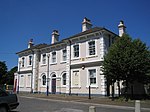Southampton Water

Southampton Water is a tidal estuary north of the Solent and the Isle of Wight in England. The city of Southampton lies at its most northerly point, where the estuaries of the River Test and River Itchen meet. Along its salt marsh-fringed western shores lie the New Forest villages of Dibden, Hythe and Fawley, and the Fawley Refinery. On the slightly steeper eastern shore are the Southampton suburb of Weston, the villages of Netley and Hamble-le-Rice, and the Royal Victoria Country Park. To the south, Southampton Water enters the Solent between Calshot Spit and Hill Head. Southampton Water is an estuary with major potential for land use conflicts. An area of urban development (the Waterside) runs in the narrow band of land between Southampton Water and the New Forest National Park. Villages such as Marchwood, Hythe, Dibden Purlieu, Holbury and Fawley have all experienced significant growth.
Excerpt from the Wikipedia article Southampton Water (License: CC BY-SA 3.0, Authors, Images).Southampton Water
New Forest Fawley
Geographical coordinates (GPS) Address Nearby Places Show on map
Geographical coordinates (GPS)
| Latitude | Longitude |
|---|---|
| N 50.856111111111 ° | E -1.3475 ° |
Address
Cadland Creek
SO45 1TX New Forest, Fawley
England, United Kingdom
Open on Google Maps








